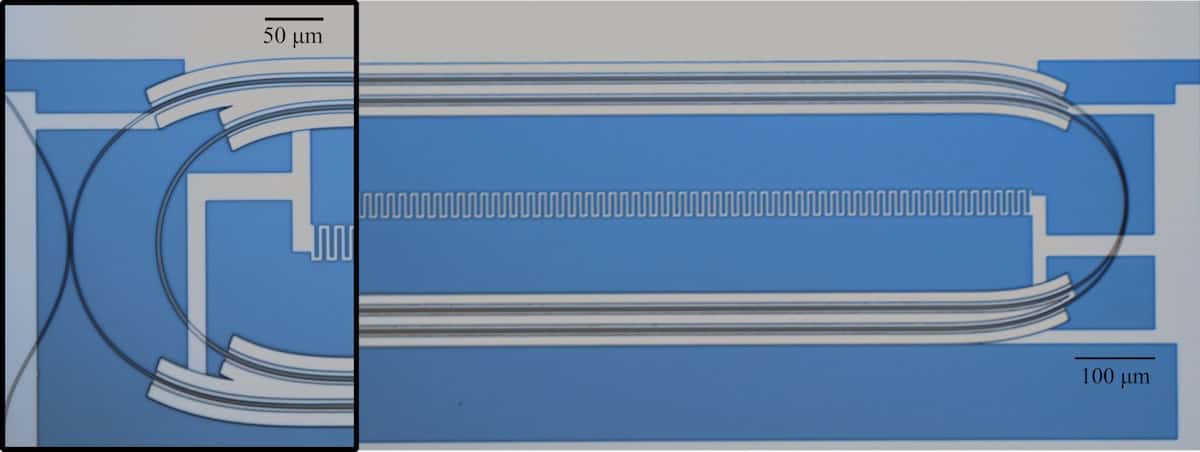
The future of quantum communication and quantum computing technologies may well revolve around superconducting qubits and quantum circuits, which have already been shown to improve processing capabilities over classical supercomputers – even when there is noise within the system. This scenario could be one step closer with the development of a novel quantum transducer by a team headed up at the Harvard John A Paulson School of Engineering and Applied Sciences (SEAS).
Realising this future will rely on systems having hundreds (or more) logical qubits (each built from multiple physical qubits). However, because superconducting qubits require ultralow operating temperatures, large-scale refrigeration is a major challenge – there is no technology available today that can provide the cooling power to realise such large-scale qubit systems.
Superconducting microwave qubits are a promising option for quantum processor nodes, but they currently require bulky microwave components. These components create a lot of heat that can easily disrupt the refrigeration systems cooling the qubits.
One way to combat this cooling conundrum is to use a modular approach, with small-scale quantum processors connected via quantum links, and each processor having its own dilution refrigerator. Superconducting qubits can be accessed using microwave photons between 3 and 8 GHz, thus the quantum links could be used to transmit microwave signals. The downside of this approach is that it would require cryogenically cooled links between each subsystem.
On the other hand, optical signals at telecoms frequency (around 200 THz) can be generated using much smaller form factor components, leading to lower thermal loads and noise, and can be transmitted via low-loss optical fibres. The transduction of information between optical and microwave frequencies is therefore key to controlling superconducting microwave qubits without the high thermal cost.
The large energy gap between microwave and optical photons makes it difficult to control microwave qubits with optical signals and requires a microwave–optical quantum transducer (MOQT). These MOQTs provide a coherent, bidirectional link between microwave and optical frequencies while preserving the quantum states of the qubit. A team led by SEAS researcher Marko Lončar has now created such a device, describing it in Nature Physics.
Electro-optic transducer controls superconducting qubits
Lončar and collaborators have developed a thin-film lithium niobate (TFLN) cavity electro-optic (CEO)-based MOQT (clad with silica to aid thermal dissipation and mitigate optical losses) that converts optical frequencies into microwave frequencies with low loss. The team used the CEO-MOQT to facilitate coherent optical driving of a superconducting qubit (controlling the state of the quantum system by manipulating its energy).
The on-chip transducer system contains three resonators: a microwave LC resonator capacitively coupled to two optical resonators using the electro-optic effect. The device creates hybridized optical modes in the transducer that enables a resonance-enhanced exchange of energy between the microwave and optical modes.
The transducer uses a process known as difference frequency generation to create a new frequency output from two input frequencies. The optical modes – an optical pump in a classical red-pumping regime and an optical idler – interact to generate a microwave signal at the qubit frequency, in the form of a shaped, symmetric single microwave photon.
This microwave signal is then transmitted from the transducer to a superconducting qubit (in the same refrigerator system) using a coaxial cable. The qubit is coupled to a readout resonator that enables its state to be read by measuring the transmission of a readout pulse.
The MOQT operated with a peak conversion efficiency of 1.18% (in both microwave-to-optical and optical-to-microwave regimes), low microwave noise generation and the ability to drive Rabi oscillations in a superconducting qubit. Because of the low noise, the researchers state that stronger optical-pump fields could be used without affecting qubit performance.
Having effectively demonstrated the ability to control superconducting circuits with optical light, the researchers suggest a number of future improvements that could increase the device performance by orders of magnitude. For example, microwave and optical coupling losses could be reduced by fabricating a single-ended microwave resonator directly onto the silicon wafer instead of on silica. A flux tuneable microwave cavity could increase the optical bandwidth of the transducer. Finally, the use of improved measurement methods could improve control of the qubits and allow for more intricate gate operations between qubit nodes.
The researchers suggest this type of device could be used for networking superconductor qubits when scaling up quantum systems. The combination of this work with other research on developing optical readouts for superconducting qubit chips “provides a path towards forming all-optical interfaces with superconducting qubits…to enable large scale quantum processors,” they conclude.
The post Quantum transducer enables optical control of a superconducting qubit appeared first on Physics World.

